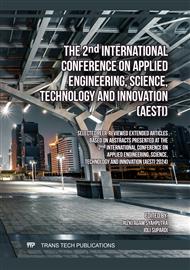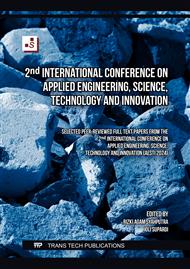[1]
William, B. Meyer, And, and B. L. TurnerII, "Human Population Growth and Global Land-Use/Cover Change on JSTOR," Annual Review of Ecology and Systematics. Accessed: Feb. 21, 2024. [Online]. Available: https://www.jstor.org/stable/2097281.
Google Scholar
[2]
R. Nedd, K. Light, M. Owens, N. James, E. Johnson, and A. Anandhi, "A Synthesis of Land Use/Land Cover Studies: Definitions, Classification Systems, Meta-Studies, Challenges and Knowledge Gaps on a Global Landscape," Land 2021, Vol. 10, Page 994, vol. 10, no. 9, p.994, Sep. 2021.
DOI: 10.3390/LAND10090994
Google Scholar
[3]
A. De Sherbinin, D. Carr, S. Cassels, and L. Jiang, "Population and Environment," Annual review of environment and resources, vol. 32, p.345, 2007.
DOI: 10.1146/ANNUREV.ENERGY.32.041306.100243
Google Scholar
[4]
N. Zalmita, Y. Alvira, and M. H. Furqan, "Analisis Perubahan Penggunaan Lahan Menggunakan Sistem Informasi Geografis (Sig) Di Gampong Alue Naga Kecamatan Syiah Kuala Tahun 2004-2019," Jurnal Geografi, vol. 9, no. 1, p.1, 2020.
DOI: 10.24036/geografi/vol9-iss1/920
Google Scholar
[5]
R. S. DeFries, J. A. Foley, and G. P. Asner, "Land-Use Choices: Balancing Human Needs and Ecosystem Function," Frontiers in Ecology and the Environment, vol. 2, no. 5, p.249, Jun. 2004.
DOI: 10.2307/3868265
Google Scholar
[6]
E. C. Ellis, "Land Use and Ecological Change: A 12,000-Year History," https://doi.org/10.1146/annurev-environ-012220-010822, vol. 46, p.1–33, Oct. 2021.
DOI: 10.1146/ANNUREV-ENVIRON-012220-010822
Google Scholar
[7]
D. M. K. S. Hemathilake and D. M. C. C. Gunathilake, "Agricultural productivity and food supply to meet increased demands," Future Foods: Global Trends, Opportunities, and Sustainability Challenges, p.539–553, Jan. 2022.
DOI: 10.1016/B978-0-323-91001-9.00016-5
Google Scholar
[8]
Ahmed and M. Misrati, "Urbanisation and Land Use Change," p.75–99, 2021.
DOI: 10.1007/978-3-030-50841-8_5
Google Scholar
[9]
Ahmed and M. Misrati, "Land Use Change, Urban Agglomeration, and Urban Sprawl: A Sustainable Development Perspective of Makassar City, Indonesia," Land 2021, Vol. 10, Page 556, vol. 10, no. 6, p.556, May 2021.
DOI: 10.3390/LAND10060556
Google Scholar
[10]
S. Patra, S. Sahoo, P. Mishra, and S. C. Mahapatra, "Impacts of urbanization on land use /cover changes and its probable implications on local climate and groundwater level," Journal of Urban Management, vol. 7, no. 2, p.70–84, Sep. 2018.
DOI: 10.1016/J.JUM.2018.04.006
Google Scholar
[11]
S. Seifollahi-Aghmiuni, Z. Kalantari, G. Egidi, L. Gaburova, and L. Salvati, "Urbanisation-driven land degradation and socioeconomic challenges in peri-urban areas: Insights from Southern Europe," Ambio, vol. 51, no. 6, p.1446, Jun. 2022.
DOI: 10.1007/S13280-022-01701-7
Google Scholar
[12]
S. Ziem Bonye, G. Yenglier Yiridomoh, and E. K. Derbile, "'Urban expansion and agricultural land use change in Ghana: Implications for peri-urban farmer household food security in Wa Municipality,'" International Journal of Urban Sustainable Development, vol. 13, no. 2, p.383–399, May 2021.
DOI: 10.1080/19463138.2021.1915790
Google Scholar
[13]
X. Luo, Z. Tong, Y. Xie, R. An, Z. Yang, and Y. Liu, "Land Use Change under Population Migration and Its Implications for Human–Land Relationship," Land 2022, Vol. 11, Page 934, vol. 11, no. 6, p.934, Jun. 2022.
DOI: 10.3390/LAND11060934
Google Scholar
[14]
N. Q. Phuc, A. C. M. van Westen, and A. Zoomers, "Agricultural land for urban development: The process of land conversion in Central Vietnam," Habitat International, vol. 41, p.1–7, Jan. 2014.
DOI: 10.1016/J.HABITATINT.2013.06.004
Google Scholar
[15]
Kusrini, Suharyadi, and S. R. Hardoyo, "5. Artikel," Flexionsmorphologie, vol. 25, no. 1, p.433–470, 2017.
DOI: 10.1515/9783110523522-024
Google Scholar
[16]
Ruslisan, "Prediksi Perubahan Penggunaan Lahan Terbangun Terhadap Kesesuaian Rancangan Tata Ruang Wilayah Menggunakan Regresi Logistic Binner Berdasar Data Spasial dan Penginderaan Jauh di Kota Semarang," Pembangunan Inklusif: Menuju ruang dan Lahan Perkotaan yang Berkeadilan, p.51–67, 2015.
DOI: 10.58812/jgws.v1i03.724
Google Scholar
[17]
A. Wijaya and C. Susetyo, "Analisis Perubahan Penggunaan Lahan di Kota Pekalongan Tahun 2003, 2009, dan 2016," Jurnal Teknik ITS, vol. 6, no. 2, p.417–420, 2017.
DOI: 10.12962/j23373539.v6i2.24454
Google Scholar
[18]
P. Prochazka et al., "Factors Influencing Farm-Land Value in the Czech Republic," Agronomy 2023, Vol. 13, Page 892, vol. 13, no. 3, p.892, Mar. 2023.
DOI: 10.3390/AGRONOMY13030892
Google Scholar
[19]
C. M. Viana, M. Santos, D. Freire, P. Abrantes, and J. Rocha, "Evaluation of the factors explaining the use of agricultural land: A machine learning and model-agnostic approach," Ecological Indicators, vol. 131, p.108200, Nov. 2021.
DOI: 10.1016/J.ECOLIND.2021.108200
Google Scholar
[20]
F. A. Astuti and H. Lukito, "Perubahan Penggunaan Lahan di Kawasan Keamanan dan Ketahanan Pangan di Kabupaten Sleman," Jurnal Geografi : Media Informasi Pengembangan dan Profesi Kegeografian, vol. 17, no. 1, p.1–6, 2020.
DOI: 10.15294/jg.v17i1.21327
Google Scholar
[21]
D. R. Siagian, R. P. Shrestha, S. Shrestha, and J. K. M. Kuwornu, "Factors Driving Rice Land Change 1989–2018 in the Deli Serdang Regency, Indonesia," Agriculture 2019, Vol. 9, Page 186, vol. 9, no. 9, p.186, Aug. 2019.
DOI: 10.3390/AGRICULTURE9090186
Google Scholar
[22]
T. Häkkinen, T. Helin, C. Antuña, S. Supper, N. Schiopu, and S. Nibel, "Land Use as an Aspect of Sustainable Building," International Journal of Sustainable Land Use and Urban Planning, vol. 1, no. 1, 2013.
DOI: 10.24102/ijslup.v1i1.202
Google Scholar
[23]
P. A. Nulhakim, S. N. Rohmah, A. Tamrin, and M. Mufidah, "Green Open Space Governance Strategy Against City Development in East Jakarta Mayor Perspective of Law Number 26 of 2007 concerning Spatial Planning," JOURNAL of LEGAL RESEARCH, vol. 4, no. 2, p.391–412, 2022.
DOI: 10.15408/jlr.v4i2.25602
Google Scholar
[24]
R. Mubarok, H. Widyasamratri, and S. P. Budi, "Analisis Perubahan Lahan Studi Kasus : Kecamatan Mijen Kota Semarang, Kota Malang, dan Bali," Jurnal Kajian Ruang, vol. 2, no. 2, p.204, 2022.
DOI: 10.30659/jkr.v2i2.26533
Google Scholar
[25]
A. Adiyanto, "The Impact of Land Conversion as a Form of Industrialization on the Community Life in Pantura," Forum Ilmu Sosial, vol. 49, no. 1, p.33–39, 2022.
DOI: 10.15294/fis.v49i1.33996
Google Scholar
[26]
A. E. Cengiz and A. E. Cengiz, "Impacts of Improper Land Uses in Cities on the Natural Environment and Ecological Landscape Planning," Advances in Landscape Architecture, Jul. 2013.
DOI: 10.5772/55755
Google Scholar
[27]
D. A. Pramono, "Sistem Informasi Geografis untuk Studi Perubahan Tutupan Lahan Vegetasi dan Non-Vegetasi di Desa Benhes," Buletin Loupe, vol. 16, no. 01, p.54–59, 2020.
DOI: 10.51967/buletinloupe.v16i01.78
Google Scholar
[28]
Ardli Swardana, "GSI Data Utilization for Change Analysis Use of Rice Fields in Garut Regency (2009-2018)," Conference on Innovation and Application of Science and Technology (CIASTECH 2020), vol. 3, no. 1, p.299–304, 2020.
Google Scholar
[29]
F. Hidayanto and A. H. H. Slamet, "Analisis Perubahan Tata Guna Lahan Berdasarkan Sistem Informasi Geografis Di Kota Pasuruan Tahun 2011-2020," Jurnal Pertanian Cemara, vol. 19, no. 2, p.23–32, 2022.
DOI: 10.24929/fp.v19i2.2233
Google Scholar
[30]
K. Jafarpour Ghalehteimouri, A. Shamsoddini, M. N. Mousavi, F. Binti Che Ros, and A. Khedmatzadeh, "Predicting spatial and decadal of land use and land cover change using integrated cellular automata Markov chain model based scenarios (2019–2049) Zarriné-Rūd River Basin in Iran," Environmental Challenges, vol. 6, p.100399, Jan. 2022.
DOI: 10.1016/J.ENVC.2021.100399
Google Scholar
[31]
P. C. Latue and H. Rakuasa, "Analysis of Land Cover Change Due to Urban Growth in Central Ternate District, Ternate City using Cellular Automata-Markov Chain," Journal of Applied Geospatial Information, vol. 7, no. 1, p.722–728, Jan. 2023.
DOI: 10.30871/JAGI.V7I1.4653
Google Scholar
[32]
S. Hussein and Werdiningsih, "Pemanfaatan Sistem Informasi Geografis (SIG) berbasis Open Source untuk Analisis Kerentanan Air Permukaan SubDAS Blongkeng," Teknologi Informasi dan Komunikasi, vol. 2012, no. Sentika, p.1–6, 2012.
DOI: 10.56244/fiki.v11i1.389
Google Scholar
[33]
B. E. Tjahjana, N. Heryana, and N. A. Wibowo, "Penggunaan sistem informasi geografis (SIG) dalam pengembangan kebun percobaan," Sirinov, vol. 3, no. 2, p.103–112, 2016.
Google Scholar
[34]
K. Marko, F. Zulkarnain, and E. Kusratmoko, "Coupling of Markov chains and cellular automata spatial models to predict land cover changes (case study: Upper Ci Leungsi catchment area)," IOP Conference Series: Earth and Environmental Science, vol. 47, no. 1, 2016.
DOI: 10.1088/1755-1315/47/1/012032
Google Scholar
[35]
M. Pratami, D. Susiloningtyas, and Supriatna, "Modelling cellular automata for the development of settlement area Bengkulu City," IOP Conference Series: Earth and Environmental Science, vol. 311, no. 1, 2019.
DOI: 10.1088/1755-1315/311/1/012073
Google Scholar
[36]
D. P. Ward, A. T. Murray, and S. R. Phinn, "A stochastically constrained cellular model of urban growth," Computers, Environment and Urban Systems, vol. 24, no. 6, p.539–558, Nov. 2000.
DOI: 10.1016/S0198-9715(00)00008-9
Google Scholar
[37]
R. White and G. Engelen, "High-resolution integrated modelling of the spatial dynamics of urban and regional systems," Computers, Environment and Urban Systems, vol. 24, no. 5, p.383–400, Sep. 2000.
DOI: 10.1016/S0198-9715(00)00012-0
Google Scholar
[38]
A. Gharaibeh, A. Shaamala, R. Obeidat, and S. Al-Kofahi, "Improving land-use change modeling by integrating ANN with Cellular Automata-Markov Chain model," Heliyon, vol. 6, no. 9, p. e05092, Sep. 2020.
DOI: 10.1016/J.HELIYON.2020.E05092
Google Scholar
[39]
H. Memarian et al., "Validation of CA-Markov for Simulation of Land Use and Cover Change in the Langat Basin, Malaysia," Journal of Geographic Information System, vol. 4, no. 6, p.542–554, Dec. 2012.
DOI: 10.4236/JGIS.2012.46059
Google Scholar
[40]
I. Santé, A. M. García, D. Miranda, and R. Crecente, "Cellular automata models for the simulation of real-world urban processes: A review and analysis," Landscape and Urban Planning, vol. 96, no. 2, p.108–122, May 2010.
DOI: 10.1016/J.LANDURBPLAN.2010.03.001
Google Scholar
[41]
S. K. Singh, S. Mustak, P. K. Srivastava, S. Szabó, and T. Islam, "Predicting Spatial and Decadal LULC Changes Through Cellular Automata Markov Chain Models Using Earth Observation Datasets and Geo-information," Environmental Processes, vol. 2, no. 1, p.61–78, Mar. 2015.
DOI: 10.1007/s40710-015-0062-x
Google Scholar
[42]
F. Wu, "Calibration of stochastic cellular automata: the application to rural-urban land conversions," International Journal of Geographical Information Science, vol. 16, no. 8, p.795–818, Dec. 2002.
DOI: 10.1080/13658810210157769
Google Scholar
[43]
D. O'Sullivan, "Graph-Cellular Automata: A Generalised Discrete Urban and Regional Model," Environment and Planning B, vol. 28, no. 5, p.687–705, 2001.
DOI: 10.1068/B2707
Google Scholar
[44]
R. R. Regmi, S. K. Saha, and M. K. Balla, "Geospatial analysis of land use land cover change predictive modeling at Phewa Lake watershed of Nepal," International Journal of Current Engineering and Technology, vol. 4, no. 4, p.2617–2627, 2014.
DOI: 10.3126/hj.v6i0.18363
Google Scholar
[45]
Q. Weng, "Land use change analysis in the Zhujiang Delta of China using satellite remote sensing, GIS and stochastic modelling," Journal of Environmental Management, vol. 64, no. 3, p.273–284, Mar. 2002.
DOI: 10.1006/JEMA.2001.0509
Google Scholar
[46]
A. K. Hua, "Application of CA-Markov model and land use/land cover changes in Malacca river watershed, Malaysia," Applied Ecology and Environmental Research, vol. 15, no. 4, p.605–622, 2017.
DOI: 10.15666/aeer/1504_605622
Google Scholar
[47]
J. Nouri, A. Gharagozlou, R. Arjmandi, S. Faryadi, and M. Adl, "Predicting Urban Land Use Changes Using a CA-Markov Model," Arabian Journal for Science and Engineering, vol. 39, no. 7, p.5565–5573, Jul. 2014.
DOI: 10.1007/s13369-014-1119-2
Google Scholar
[48]
S. Kumar, N. Radhakrishnan, and S. Mathew, "Land use change modelling using a Markov model and remote sensing," Geomatics, Natural Hazards and Risk, vol. 5, no. 2, p.145–156, 2014.
DOI: 10.1080/19475705.2013.795502
Google Scholar
[49]
M. D. Behera et al., "Modelling and analyzing the watershed dynamics using Cellular Automata (CA)-Markov model - A geo-information based approach," JESS, vol. 121, no. 4, p.1011–1024, 2012.
DOI: 10.1007/S12040-012-0207-5
Google Scholar
[50]
K. P. Sheladiya and C. R. Patel, "An Application of Cellular Automata (CA) and Markov Chain (MC) Model in Urban Growth Prediction: A case of Surat City, Gujarat, India," Geoplanning, vol. 10, no. 1, p.23–36, 2023.
DOI: 10.14710/geoplanning.10.1.23-36
Google Scholar
[51]
L. Sang, C. Zhang, J. Yang, D. Zhu, and W. Yun, "Simulation of land use spatial pattern of towns and villages based on CA–Markov model," Mathematical and Computer Modelling, vol. 54, no. 3–4, p.938–943, Aug. 2011.
DOI: 10.1016/J.MCM.2010.11.019
Google Scholar
[52]
E. R. da Cunha, C. A. G. Santos, R. M. da Silva, V. M. Bacani, and A. Pott, "Future scenarios based on a CA-Markov land use and land cover simulation model for a tropical humid basin in the Cerrado/Atlantic forest ecotone of Brazil," Land Use Policy, vol. 101, p.105141, Feb. 2021.
DOI: 10.1016/J.LANDUSEPOL.2020.105141
Google Scholar
[53]
O. G. Varga, R. G. Pontius, S. K. Singh, and S. Szabó, "Intensity Analysis and the Figure of Merit's components for assessment of a Cellular Automata – Markov simulation model," Ecological Indicators, vol. 101, p.933–942, Jun. 2019.
DOI: 10.1016/J.ECOLIND.2019.01.057
Google Scholar
[54]
S. Saadani, R. Laajaj, M. Maanan, H. Rhinane, and A. Aaroud, "Simulating spatial–temporal urban growth of a Moroccan metropolitan using CA–Markov model," Spatial Information Research, vol. 28, no. 5, p.609–621, Oct. 2020.
DOI: 10.1007/S41324-020-00322-0
Google Scholar



